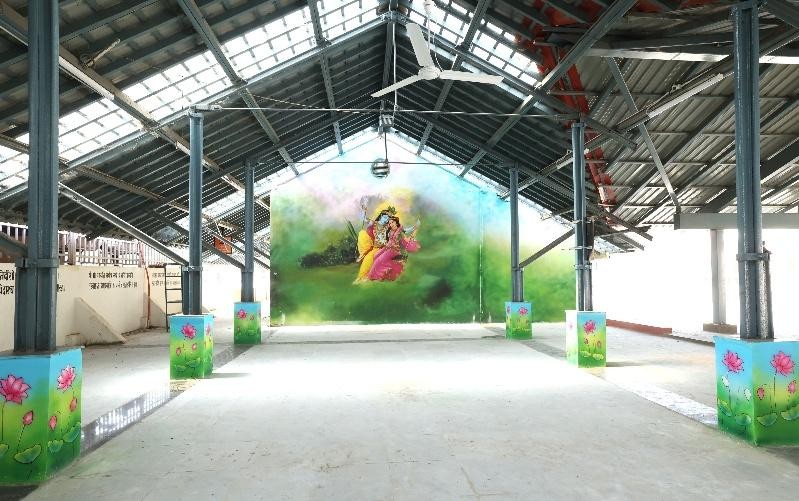Ministry of Railways
Redevelopment of Dakor Station of Vadodara Division of Western Railway
TRANSFORMING GUJARAT'S RAILWAY LANDSCAPE: THE AMRIT BHARAT STATION SCHEME
Posted On:
21 MAY 2025 4:57PM by PIB Ahmedabad
Indian Railways is known as the lifeline of the country. Railway stations play a crucial role in rail operations and also serve as the identity of their respective cities. Most railway stations are at the heart of the city, around which the city’s economic, social, and cultural activities revolve. Therefore, it is necessary to develop these stations in such a way that they not only function as transit points but also become symbols of the city’s identity. When beautiful and grand stations are developed based on the cultural, spiritual, and religious heritage of the city, they leave a lasting impression on both domestic and international tourists arriving by train.
India's global credibility has increased under the able leadership of Hon’ble Prime Minister Shri Narendra Modi. While laying the foundation stone for the redevelopment of various railway stations, the Prime Minister stated, “India, which is moving towards the goal of development, is at the beginning of its Amrit Kaal. There is new energy, new inspiration, new resolutions.” Inspired by the Hon’ble PM, Indian Railways initiated the rejuvenation of more than 1,300 railway stations. Now, in less than two years, 103 redeveloped railway stations are set to be inaugurated under the Amrit Bharat Station Scheme (ABSS). This pace of redevelopment is unprecedented. The Prime Minister has often said that the projects for which he lays the foundation stone are also inaugurated by him. This reflects the new culture of a developing India, where the speed of project completion has significantly increased. Indian Railways deserves appreciation for the remarkable pace at which this work has been accomplished.
Of the more than 1,300 stations being developed under the Amrit Bharat Station Scheme, the 103 completed stations feature grand entrance gates, attractive facades, high-mast lighting, modern waiting rooms, ticket counters, upgraded toilets, and accessible ramps for Divyangjan. Additionally, shelters, coach indication systems, and digital displays have been installed on the platforms. All facilities are Divyangjan-friendly. At the same time, a glimpse of Gujarat’s folk art, culture, and traditions can also be seen at every station.
Dakor Railway Station: A Pilgrimage Hub Renewed

Steeped in spiritual significance and cultural heritage, Dakor in Gujarat’s Kheda district has long drawn pilgrims and travelers alike to the revered temple of Ranchhodrayji. As the city’s main railway gateway, Dakor Railway Station plays a crucial role in facilitating access to this holy town. Classified as an NSG-6 station on the Anand–Godhra section under the Vadodara Division of Western Railway, Dakor Station has now been transformed into a modern and inclusive transit point under the Amrit Bharat Station Scheme.

With a revitalization budget of Rs 5.88 crore under Phase I, Dakor Railway Station has undergone extensive upgrades while thoughtfully preserving its heritage appeal. The existing station building has been renovated to retain its original architectural charm, now complemented by aesthetically designed porches that enhance both functionality and visual appeal. The addition of a prominent new porch offers passengers a shaded, structured area for pickup and drop-off, creating a welcoming and convenient entryway.

The station’s platforms have been resurfaced and fitted with tactile guidance tiles, warning tiles, and low-height water taps to ensure comfort and accessibility for Divyangjan passengers. Renovated platform coversheds not only provide protection from the weather elements but also contribute to better crowd management and passenger comfort.
Accessibility has been a key focus in Dakor’s transformation. The station now features spacious parking areas for two-wheelers, four-wheelers and dedicated slots for Divyangjan passengers. Additional facilities include Divyangjan-friendly toilets, accessible signage, ramps, and tactile paths. A six-meter-wide Foot over Bridge ensures smooth and inclusive movement across platforms.
To reflect the city’s spiritual identity, a statue and mural of Lord Krishna have been gracefully integrated into the station premises, preserving the town’s pilgrimage legacy. The redesigned circulating area features widened lanes, structured parking, and dedicated pedestrian pathways, enabling smoother traffic flow and ease of access.
Modern signages, improved lighting, and an upgraded passenger information system enhance navigation and safety for all users. Landscaped green zones further uplift the station's atmosphere, adding a touch of serenity to the travel experience.
By merging tradition with modernity, Dakor railway station now stands as a symbol of thoughtful urban development—honouring its sacred past while embracing the future of inclusive and efficient railway travel.
The wheels of the train symbolize the wheels of the country’s development. Railway stations are key centres driving the nation’s progress. Every Indian has a role to play in the advancement of Indian Railways and its stations. This participation must be further strengthened. It is also our collective responsibility to protect and maintain these stations with cleanliness and care.
AP/IJ/GP/JD
(Release ID: 2130273)
Visitor Counter : 13